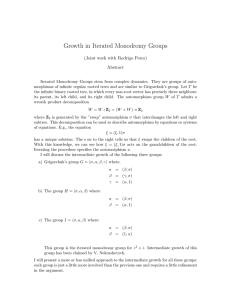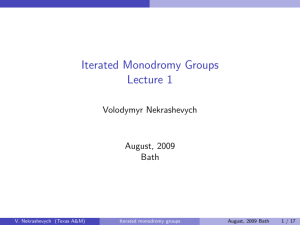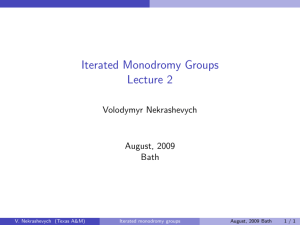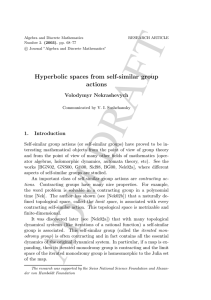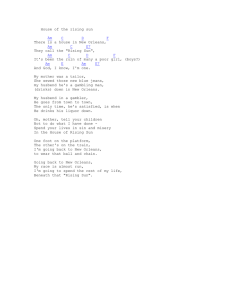Self-similar groups and hyperbolic groupoids I Volodymyr Nekrashevych June 21, 2012, Orleans
advertisement
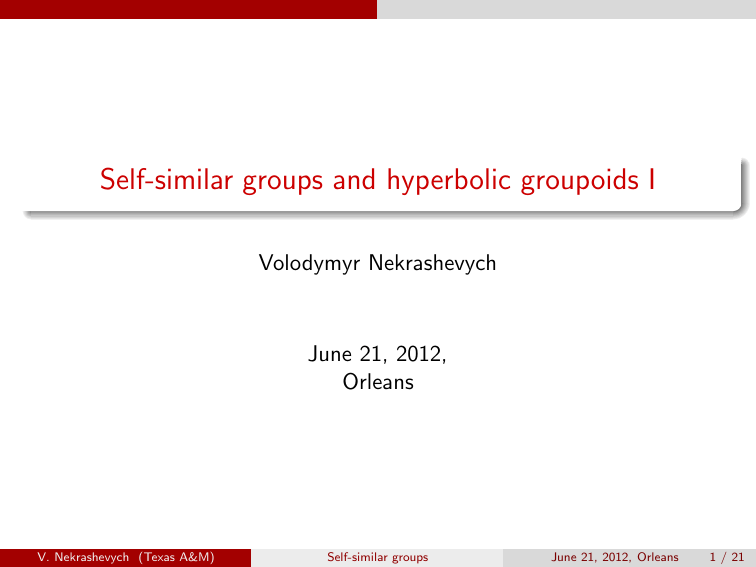
Self-similar groups and hyperbolic groupoids I
Volodymyr Nekrashevych
June 21, 2012,
Orleans
V. Nekrashevych (Texas A&M)
Self-similar groups
June 21, 2012, Orleans
1 / 21
Self-similar groups
Self-similar groups
Definition
Let X be a finite alphabet. A self-similar group is a faithful action of a
group G on the set X∗ of finite words such that for every g ∈ G and x ∈ X
there exist h ∈ G and y ∈ X such that
g (xw ) = yh(w )
for all w ∈ X∗ .
Example: consider X = {0, 1} and let a be defined by
a(0w ) = 1w ,
a(1w ) = 0a(w ).
This is the rule of adding 1 to a dyadic integer. The transformation a (and
the corresponding action of Z) is called the adding machine.
V. Nekrashevych (Texas A&M)
Self-similar groups
June 21, 2012, Orleans
2 / 21
Self-similar groups
Wreath recursions
It is easy to define a finitely generated self-similar group. Just choose for
every generator g a permutation π ∈ SX and elements gx ∈ G for all
x ∈ X, and then define
g (xw ) = π(x)gx (w )
for all w ∈ X∗ . For example, take G = ha, bi and X = {O, I , J}, where
a(Ow ) = Iw ,
a(Iw ) = Oa(w ),
b(Ow ) = Jw ,
b(Iw ) = Iw ,
a(Jw ) = Jw
b(Jw ) = Ob(w )
The rules can be compactly written as homomorphisms
G −→ G o SX : g 7→ (gx )π, called wreath recursions.
V. Nekrashevych (Texas A&M)
Self-similar groups
June 21, 2012, Orleans
3 / 21
Self-similar groups
If gx are also generators, the group is generated by a finite automaton. For
example, the adding machine action is described by the following graph.
To find g (x1 x2 . . .), find a directed path starting at g and labeled by
(x1 , y1 ), (x2 , y2 ), . . .. Then g (x1 x2 . . .) = y1 y2 . . ..
V. Nekrashevych (Texas A&M)
Self-similar groups
June 21, 2012, Orleans
4 / 21
Self-similar groups
Bisets
Let (G , X) be a self-similar group. Identify letters x ∈ X with
transformations
w 7→ xw .
Then the equality g (xw ) = ygx (w ) can be written as an equality of
compositions of transformations:
g · x = y · gx .
Note that the set X · G is invariant under post- and pre-compositions with
elements of G :
g · (x · h) = y · (gx h),
(x · h) · g = x · (hg ).
We get a biset: a set with commuting left and right actions of G .
V. Nekrashevych (Texas A&M)
Self-similar groups
June 21, 2012, Orleans
5 / 21
Self-similar groups
Covering bisets
The right action of G on X · G is free (i.e., m · g = m implies g = 1) and
has |X| orbits labeled by the letters of X (since x · h · g = x · (hg )).
Definition
A biset M is a covering biset if the right action is free and has a finite
number of orbits.
V. Nekrashevych (Texas A&M)
Self-similar groups
June 21, 2012, Orleans
6 / 21
Self-similar groups
Let M be a covering G -biset. Choose a right orbit transversal Y ⊂ M, i.e.,
choose one element in each orbit. Then for every g ∈ G and x ∈ Y the
element g · x ∈ M can be uniquely written as
g ·x =y ·h
for some y ∈ Y and h ∈ G . We get the associated action on Y∗ defined
recurrently by the condition that
g (xw ) = yh(w )
for all w ∈ X∗ if g · x = y · h.
V. Nekrashevych (Texas A&M)
Self-similar groups
June 21, 2012, Orleans
7 / 21
Self-similar groups
Consider the set M of transformations of R of the form x 7→ (x + n)/2 for
n ∈ Z. Z acts on R in the usual way. Then M is invariant under pre- and
post-compositions with elements of Z:
x 7→ (x + m + n)/2,
x 7→ (x + n)/2 + m = (x + n + 2m)/2.
The action by post-compositions has two orbits (corresponding to parity of
n).
If we choose the transversal {f0 = x/2, f1 = (x + 1)/2}, then the generator
a : x 7→ x + 1 satisfies (for the right action):
x · (a · f0 ) = (x + 1)/2 = x · f1 ,
x · (a · f1 ) = (x + 2)/2 = x/2 + 1 = x · f0 · a.
We see that the action associated with the biset is the adding machine.
V. Nekrashevych (Texas A&M)
Self-similar groups
June 21, 2012, Orleans
8 / 21
Iterated monodromy groups
Iterated monodromy groups
Let f : M1 −→ M be a finite covering map, where M1 ⊂ M. In general,
one can consider a pair of maps f : M1 −→ M and ι : M1 −→ M.
Choose
t ∈ M and consider the tree of preimages
F a basepoint
−n (t):
T = ∞
f
n=0
V. Nekrashevych (Texas A&M)
Self-similar groups
June 21, 2012, Orleans
9 / 21
Iterated monodromy groups
Iterated monodromy group
The fundamental group π1 (M, t) acts on T by the monodromy actions on
each of the levels f −n (t).
The obtained action is the iterated monodromy action. The quotient of
π1 (M, t) by the kernel of the iterated mondromy action is the iterated
monodromy group IMG(f ).
V. Nekrashevych (Texas A&M)
Self-similar groups
June 21, 2012, Orleans
10 / 21
Iterated monodromy groups
Associated biset
Let Mf be the set of homotopy classes of paths in M from t to a point
z ∈ f −1 (t).
The fundamental group acts on Mf by attaching loops to the beginning t
and lifts of loops by f to the ends z ∈ f −1 (t) of elements of Mf
It is easy to see that the two actions commute. The first action is free.
The number of its orbits is equal to |f −1 (t)|, where the orbits are in a
bijection with the ends of paths ` ∈ M.
V. Nekrashevych (Texas A&M)
Self-similar groups
June 21, 2012, Orleans
11 / 21
Iterated monodromy groups
It is easy to check that the self-similar action of π1 (M, t) associated with
the biset Mf is conjugate to the iterated monodromy action.
Choosing a right orbit transversal, i.e., a collection of paths `x starting in t
and ending in L(x) ∈ f −1 (t) (where x ∈ X, |X| = deg f , and
L : X −→ f −1 (t) is a bijection) we get the standard self-similar action of
the iterated monodromy group, and a labeling of the vertices of T by
words over X.
V. Nekrashevych (Texas A&M)
Self-similar groups
June 21, 2012, Orleans
12 / 21
Iterated monodromy groups
The point labeled by xv is the end of the lift of the path `x by f |v | starting
at the point labeled by v .
V. Nekrashevych (Texas A&M)
Self-similar groups
June 21, 2012, Orleans
13 / 21
Iterated monodromy groups
Let {`x } and L : X −→ f −1 (t), be as before. Let γ ∈ π1 (M, t), and let γx
be the lift of γ starting at L(x). Let L(y ) be the end of γx . Then the
standard action is given by the rule
γ(xw ) = y (`−1
y γx `x )(w ).
V. Nekrashevych (Texas A&M)
Self-similar groups
June 21, 2012, Orleans
14 / 21
Iterated monodromy groups
3
The “interlaced adding machine” is the i.m.g. of f (z) = − z2 +
the map C \ {±1, ±2} −→ C \ {±1}.
V. Nekrashevych (Texas A&M)
Self-similar groups
3z
2
seen as
June 21, 2012, Orleans
15 / 21
Iterated monodromy groups
IMG(−z 3/2 + 3z/2) continued
a(Ow ) = Iw ,
a(Iw ) = Oa(w ),
b(Ow ) = Jw ,
b(Iw ) = Iw ,
V. Nekrashevych (Texas A&M)
Self-similar groups
a(Jw ) = Jw
b(Jw ) = Ob(w ).
June 21, 2012, Orleans
16 / 21
Iterated monodromy groups
A multi-dimensional example
Consider the map F of C2 :
(x, y ) 7→
1
y2
1 − 2,1 − 2
x
x
It can be naturally extended to the projective plane.
(x : y : z) 7→ (x 2 − y 2 : x 2 − z 2 : x 2 ).
The set {x = 0} ∪ {y = 0} ∪ {z = 0} is the critical locus. The
post-critical set is the union of the line at infinity with the lines
x = 0, x = 1, y = 0, y = 1, x = y .
They are permuted as follows:
{x = 0} 7→ {z = 0} 7→ {y = 1} 7→ {x = y } 7→ {x = 0}
{y = 0} 7→ {x = 1} 7→ {y = 0}.
V. Nekrashevych (Texas A&M)
Self-similar groups
June 21, 2012, Orleans
17 / 21
Iterated monodromy groups
The iterated monodromy group of F (as computed by J. Belk and
S. Koch) is generated by the transformations:
a(1v ) = 1b(v ),
a(2v ) = 2v ,
a(3v ) = 3v ,
b(1v ) = 1c(v ),
b(2v ) = 2c(v ),
a(4v ) = 4b(v ),
b(3v ) = 3v ,
b(4v ) = 4v ,
c(1v ) = 4d(v ), c(2v ) = 3(ceb)−1 (v ), c(3v ) = 2(fa)−1 (v ), c(4v ) = 1v ,
d(1v ) = 2v ,
d(2v ) = 1a(v ),
e(1v ) = 1f (v ),
f (1v ) = 3b −1 (v ),
V. Nekrashevych (Texas A&M)
e(2v ) = 2v ,
f (2v ) = 4v ,
d(3v ) = 4v ,
d(4v ) = 3a(v ),
e(3v ) = 3f (v ),
f (3v ) = 1eb(v ),
Self-similar groups
e(4v ) = 4v ,
f (4v ) = 2e(v ).
June 21, 2012, Orleans
18 / 21
Iterated monodromy groups
Bimodules
We have described a relation between two structures: pairs of maps
f , ι : M1 −→ M, where f is a covering map (and ι was an embedding),
and G -bisets M. Both define bimodules over algebras.
V. Nekrashevych (Texas A&M)
Self-similar groups
June 21, 2012, Orleans
19 / 21
Iterated monodromy groups
In the case of a pair of maps f , ι : M1 −→ M, consider the algebra
A = C0 (M) of continuous functions on M, and the space Φ = C0 (M1 ) of
continuous functions on M1 . Let Φ be a right module w.r.t.
φ · a(x) = φ(x)a(f (x)), x ∈ M1
with A-valued inner product
hφ1 |φ2 i(x) =
X
φ1 (z)φ2 (z).
z∈f −1 (x)
Define a structure of a left A-module on Φ by
(a · φ)(x) = a(ι(x))φ(x), x ∈ M1 .
V. Nekrashevych (Texas A&M)
Self-similar groups
June 21, 2012, Orleans
20 / 21
Iterated monodromy groups
In the case of a covering biset M over a group G , consider the group ring
A = C[G ] and the linear space Φ spanned by M. Since G acts by
commuting left and right actions on M, extending the action by linearity,
we get a bimodule structure on Φ.
We also have an A-valued inner product on Φ given by the condition that
if x, y ∈ M are such that y = x · g for some g ∈ G , then hx|y i = g ;
otherwise hx|y i = 0.
V. Nekrashevych (Texas A&M)
Self-similar groups
June 21, 2012, Orleans
21 / 21
